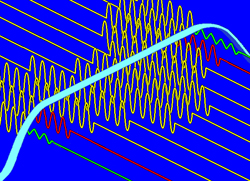
Video delay, also called frame delay, is a result of the amount of time needed to process a video signal by electronic components.
In general, there will always be some amount of delay that is inherent in even the simplest video system. This delay can occur at any processing point in the video path, and the amount of delay created by different system components varies.
By comparison, the audio signal that accompanies video content is generally a much smaller bandwidth signal and is not subjected to complex processing, so very little audio delay is created.
In most cases, where simple video processing electronics are employed, the video delay is not noticeably greater than the audio delay; thus, the viewer observes no delay impact. In other cases, where complex video processing or signal distribution is occurring, the delay can add up to a number of frames, which is more than enough to create a noticeable, non-synchronous presentation of audio and video.
Causes
So what causes increases in video delay? As one example, employing warp electronics to apply geometric correction to an image can result in noticeable increases in video delay. Another contributing factor can be the use of a scaler or a signal processing that performs video noise reduction.
Video delay can also occur in applications where very high bandwidth 3D images are being processed. All of the aforementioned electronic capabilities can be found in both projectors and external processing components.
The primary question to answer remains: is the sum delay of all the video processing and distribution enough to cause a noticeable time difference between the audio and the video?
Effect
The symptom of video delay is that the video information lags behind the audio information. In simple terms, video and audio become unsynchronized.
In cases where live camera shots support an on-stage speaker with magnified video projection (also known as IMAG), one might also notice that the speaker’s movements on the projection screen lag behind what the presenter is actually doing.
Solutions
When significant video delay is unavoidable in a non-live presentation system design such as a boardroom or a home theater, the simplest solution is to intentionally delay the audio to resynchronize it with the video. In many cases, this audio delay is accomplished with equipment specifically designed for that task.
In live events with IMAG, such as concerts or religious applications, the viewers are observing the same activity on stage that is being projected and heard. In that scenario, if audio delay is employed to match the video delay of the system, the audio and video will be synchronized, but there will not be synchronization between what the viewers simultaneously observe – the live action compared to the IMAG action.
The best solution to the live event challenge is to minimize video delay in the design of the video system. Minimizing video delay normally means employing as few distribution components as possible and keeping image processing, warp correction and signal processing to the bare bones of what the application demands.
Avoid multiple analog to digital conversions and never use more than one scaler in the video path. Be sure to remember, many projectors include built-in scalers, so if you are using external scaling electronics, the projector’s scaler should be set to native.
Also, distributing digital video “end-to-end” throughout your entire signal path will help assure the integrity of your signal quality.
Conclusion
Due to the nature of how electrons move through electronic devices, there will always be some element of delay in any video system design. In certain applications, image processing such as geometric warp is an absolute requirement, so it is best to plan ahead and consider if audio delay can provide a good solution.
Most video processor and projector manufacturers can provide data defining the video delay characteristics of their products. It is normally described as “lines of delay,” which have minimal impact, or frames of delay, which is much more significant. You should always understand the delay characteristics of each component within your systems so you can estimate the approximate video delay any system design will introduce.
This article was provided by Digital Projection.
